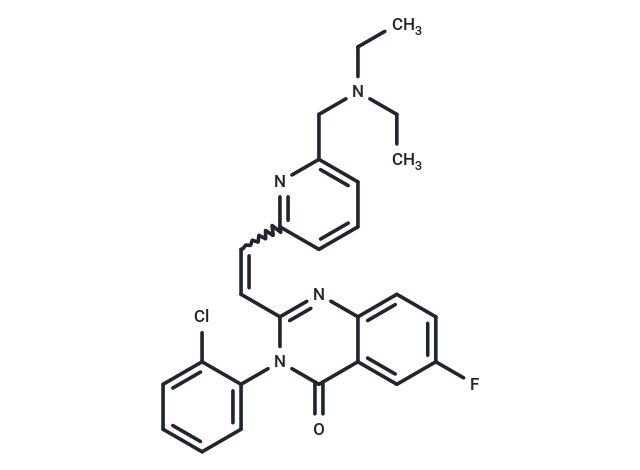Shopping Cart
Remove All Your shopping cart is currently empty
Your shopping cart is currently empty
CP 465022 hydrochloride is a potent, and selective noncompetitive antagonist of AMPA receptor with anticonvulsant activity. CP 465022 hydrochloride inhibits Kainate-induced response with an IC50 of 25 nM in rat cortical neurons.

| Pack Size | Price | USA Warehouse | Global Warehouse | Quantity |
|---|---|---|---|---|
| 5 mg | $30 | In Stock | In Stock | |
| 10 mg | $46 | In Stock | In Stock | |
| 25 mg | $100 | In Stock | In Stock | |
| 50 mg | $175 | In Stock | In Stock |
| Description | CP 465022 hydrochloride is a potent, and selective noncompetitive antagonist of AMPA receptor with anticonvulsant activity. CP 465022 hydrochloride inhibits Kainate-induced response with an IC50 of 25 nM in rat cortical neurons. |
| Targets&IC50 | Kainate-induced response:25 nM (rat cortical neurons) |
| In vitro | CP 465022 hydrochloride 1 µM for 10 min has little effect on peak NMDA-induced currents but reduces current measured at 8 s during NMDA application by 26%.CP-465,022 at 10 µM inhibits peak NMDA-induced currents in cortical neurons by 36% and currents measured at 8 s by 70% d in primary cultures of cortical and cerebellar granule neurons. CP 465022 hydrochloride (0.0001 μM-10 μM) inhibits kainate-induced response in relatively slow manner and dependents on compound concentration, exhibiting a calculated IC50 of 25 nM and essentially complete inhibition at 3.2 µM. CP 465022 hydrochloride 1 µM for 10 min inhibits peak NMDA currents in cultured rat cerebellar granule neurons with mean inhibition of 19% and NMDA currents measured at 8 s by 45%, similar to what is observed in the cortical neurons. CP 465022 hydrochloride (100 nM -10 µM) has inhibitory effects on Kainate-induced whole-cell currents in voltage-clamped rat hippocampal, 100 nM CP465,022 inhibits kainate currents developed over the course of 200s, 500 nM and 1 µM CP-465,022 nearly complete inhibits this time frame (99.3%)[1]. |
| Molecular Weight | 462.95 |
| Formula | C26H24ClFN4O |
| Cas No. | 199655-36-2 |
| Smiles | CCN(CC)Cc1cccc(C=Cc2nc3ccc(F)cc3c(=O)n2-c2ccccc2Cl)n1 |
| Relative Density. | 1.23 g/cm3 (Predicted) |
| Storage | Powder: -20°C for 3 years | In solvent: -80°C for 1 year | Shipping with blue ice/Shipping at ambient temperature. | ||||||||||||||||||||
| Solubility Information | DMSO: 4.63 mg/mL (10 mM), Sonication is recommended. | ||||||||||||||||||||
Solution Preparation Table | |||||||||||||||||||||
DMSO
| |||||||||||||||||||||
| Size | Quantity | Unit Price | Amount | Operation |
|---|

Copyright © 2015-2026 TargetMol Chemicals Inc. All Rights Reserved.